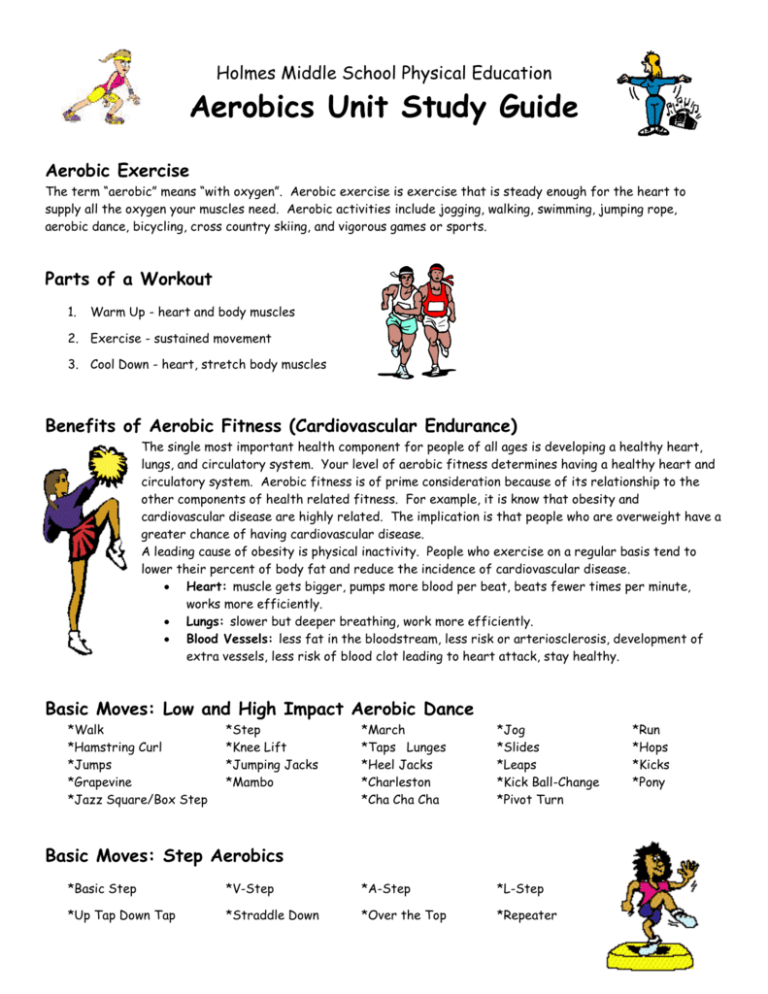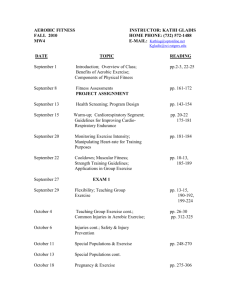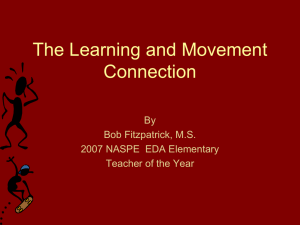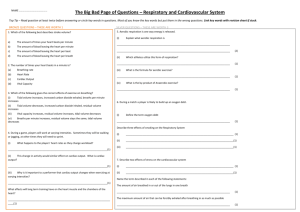Aerobics Study Guide - Holmes Middle School
advertisement

Holmes Middle School Physical Education Aerobics Unit Study Guide Aerobic Exercise The term “aerobic” means “with oxygen”. Aerobic exercise is exercise that is steady enough for the heart to supply all the oxygen your muscles need. Aerobic activities include jogging, walking, swimming, jumping rope, aerobic dance, bicycling, cross country skiing, and vigorous games or sports. Parts of a Workout 1. Warm Up - heart and body muscles 2. Exercise - sustained movement 3. Cool Down - heart, stretch body muscles Benefits of Aerobic Fitness (Cardiovascular Endurance) The single most important health component for people of all ages is developing a healthy heart, lungs, and circulatory system. Your level of aerobic fitness determines having a healthy heart and circulatory system. Aerobic fitness is of prime consideration because of its relationship to the other components of health related fitness. For example, it is know that obesity and cardiovascular disease are highly related. The implication is that people who are overweight have a greater chance of having cardiovascular disease. A leading cause of obesity is physical inactivity. People who exercise on a regular basis tend to lower their percent of body fat and reduce the incidence of cardiovascular disease. Heart: muscle gets bigger, pumps more blood per beat, beats fewer times per minute, works more efficiently. Lungs: slower but deeper breathing, work more efficiently. Blood Vessels: less fat in the bloodstream, less risk or arteriosclerosis, development of extra vessels, less risk of blood clot leading to heart attack, stay healthy. Basic Moves: Low and High Impact Aerobic Dance *Walk *Hamstring Curl *Jumps *Grapevine *Jazz Square/Box Step *Step *Knee Lift *Jumping Jacks *Mambo *March *Taps Lunges *Heel Jacks *Charleston *Cha Cha Cha *Jog *Slides *Leaps *Kick Ball-Change *Pivot Turn Basic Moves: Step Aerobics *Basic Step *V-Step *A-Step *L-Step *Up Tap Down Tap *Straddle Down *Over the Top *Repeater *Run *Hops *Kicks *Pony *Turn Step *Knee Up FITT Principle F = Frequency, number of aerobic workouts per week (3 or more X’s) I = Intensity, level of an exercise bout as measured by your heart rate (60-75% THR) T = Time, length of an aerobic workout (20-30 minutes) T = Type, kind of exercise being performed (various) How to Measure Aerobic Intensity 1. Quick Check Too Easy Medium Hard Very Hard Too Hard Not sweating, heart beats at usual pace, breathing normally Begin to sweat lightly, feel heat beating quickly, you hear yourself breathing Sweating, heart is beating fast, breathing hard Sweating a lot, heart is racing, breathing very hard Sweating a great deal, out of breath, wobbly legs 2. Heart Rate Measuring and knowing you heart rate while exercising can tell you whether or not your heart is beating fast enough (or too fast) during physical activity. If your heart rate isn’t at a specific rate during exercise, your cardiovascular system is not getting an adequate workout. You will find that your body does not become more fit unless you are working within your target heart rate range. Your target heart rate (THR) depends on your age and current level of fitness. When you take your pulse rate in class, you can find it on the thumb side of your write (radial pulse) or on the side of your neck (carotid pulse). Always count the first beat as zero. Count your pulse beats for six seconds. When you are done counting, put a zero on the end of the number you counted. This will give you your rate for one minute. For example, if you count 15 beats during six seconds, your heart rate would be 150. See Heart Rate Sheet! Definitions Aerobic: Oxygen-using. Aerobic Dance Exercising: A method of exercising to music that conditions the cardiovascular system by using movements that creates an increased demand for oxygen over an extended time. Anaerobic: Without oxygen. Beats: A pattern of strong and weak pulsations that have an even rhythm. Rhythm: A regular pattern of movement or sound. Step Workout: A type of aerobic conditioning that incorporates a bench between 4 and 10 inches high. Target Heart Rate: The number of heartbeats per minute that indicates appropriate exercise intensity levels for each person. Also called training heart rate. Tempo: The rate of speed at which a musical composition is played. 4/2008





